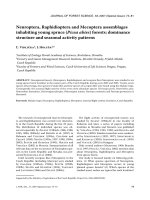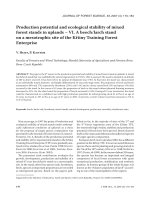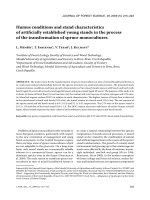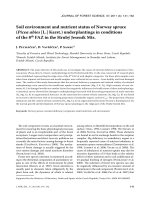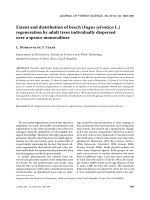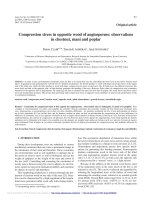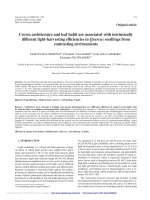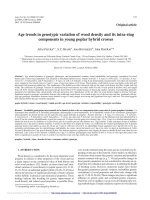Báo cáo lâm nghiệp: "Light acclimation and photosynthetic response of beech (Fagus sylvatica L.) saplings under artificial shading or natural Mediterranean conditions" docx
Bạn đang xem bản rút gọn của tài liệu. Xem và tải ngay bản đầy đủ của tài liệu tại đây (1.06 MB, 10 trang )
257
Ann. For. Sci. 63 (2006) 257– 266
© INRA, EDP Sciences, 2006
DOI: 10.1051/forest:2006004
Original article
Light acclimation and photosynthetic response of beech
(Fagus sylvatica L.) saplings under artificial shading or natural
Mediterranean conditions
Julien PARELLE
a,b
, Jean-Philippe ROUDAUT
a
, Michel DUCREY
a
a
INRA, Unité de Recherches Forestières Méditerranéennes, Avenue A. Vivaldi, 84 000 Avignon, France
b
Present address: UMR INRA-UHP Écologie et Écophysiologie Forestières, INRA - Centre de Nancy, 54280 Champenoux, France
(Received 23 June 2005; accepted 29 September 2005)
Abstract – Acclimation of beech (Fagus sylvatica L.) to different light conditions was studied in natural regeneration below black pine canopies
(Pinus nigra ssp. nigricans) in Mont-Ventoux (Vaucluse, France) and with potted saplings – from the same origin – under shaded tunnels in
southern France (Avignon, Vaucluse), and north-eastern France (Nancy, Meurthe-et-Moselle). Leaf mass to area ratio and leaf carbon content
per unit mass increased, while leaf nitrogen content per unit mass (N
m
) remained constant, with increasing relative irradiance (RI). Maximum
carboxylation rate (V
cmax
) and maximum electron transport flux (J
max
) increased with RI and were higher in the natural regeneration than in
the potted saplings. These two parameters were higher for the potted saplings in north-eastern France than for those in southern France. Leaf
nitrogen allocation to carboxylation (P
r
) or bioenergetics (P
b
) did not vary with RI. P
r
and P
b
were higher in the natural regeneration than in
the potted saplings, whereas N
m
was lower in the natural regeneration than in the fertilised potted saplings. Seasonal time course of these
parameters in the natural regeneration in Mont-Ventoux, from bud burst to the beginning of summer drought, showed that after the leaf
expansion period, leaf composition and photosynthetic parameters remain globally constant.
maximum carboxylation rate (V
cmax
) / maximum electron transport flux (J
max
) / nitrogen allocation / relative irradiance / seasonal
variability
Résumé – Acclimatation à la lumière et réponse photosynthétique de jeunes plants de hêtre (Fagus sylvatica L.) sous ombrage artificiel
ou en conditions naturelles en région méditerranéenne. L’acclimatation du hêtre (Fagus sylvatica L.) à la lumière a été étudiée dans des
régénérations naturelles sous couvert de pin noir d’Autriche (Pinus nigra ssp. nigricans) dans le Mont-Ventoux et chez des jeunes plants en
pots – de même origine – sous tunnels ombragés dans le sud de la France (Avignon, Vaucluse) et dans le nord-est de la France (Nancy, Meurthe-
et-Moselle). La masse spécifique foliaire et la teneur en carbone par unité de masse foliaire augmentent avec l’éclairement relatif (RI) alors que
la teneur en azote par unité de masse foliaire (N
m
) reste constante. La vitesse maximale de carboxylation (V
cmax
) et le flux maximum d’électrons
(J
max
) augmentent avec RI et sont plus élevés dans les régénérations naturelles que chez les plants en pots. Ces deux paramètres sont plus élevés
pour les plants en pots du nord-est que ceux du sud de la France. L’allocation de l’azote foliaire aux processus de carboxylation (P
r
) ou
bioénergétiques (P
b
) ne varie pas avec RI. P
r
et P
b
sont plus élevés pour les régénérations naturelles que pour les plants en pots alors que N
m
est plus basse pour les régénérations naturelles que pour les plants en pots qui ont été fertilisés. L’évolution saisonnière de ces paramètres, pour
les régénérations naturelles du Mont-Ventoux, depuis le débourrement jusqu’au début de la sécheresse estivale montre que, après la phase
d’expansion des feuilles, la composition foliaire et les paramètres photosynthétiques restent globalement constants.
vitesse maximale de carboxylation (V
cmax
) / flux maximum d'électrons (J
max
) / allocation de l'azote / éclairement relatif / variabilité
saisonnière
1. INTRODUCTION
Beech (Fagus sylvatica L.), a widely distributed European
forest tree, is at its French southern limit in medium altitude
mountains (between 1000 and 1500 m elevation ) of the Med-
iterranean region. Because of a high anthropic pressure, it was
almost extinct in the Mediterranean region at the end of
XIXth
century [12]. During the past decades, it has recovered a larger
distribution by colonising the understory of pioneer species,
such as black pine (Pinus nigra ssp. nigricans) that had been
extensively planted in the Mediterranean mountains at the end
of
XIXth century. The high temperature characterising Medi-
terranean climate induce a specific situation for beech. The
management of this regeneration should take in account this
* Corresponding author:
Article published by EDP Sciences and available at or />258 J. Parelle et al.
specificity in order to maintain its surviving. However little is
known about ecophysiology of beeches in such extreme cli-
matic conditions.
Position of species in forest successions is governed by sev-
eral ecological factors such as shade tolerance [4]. Pioneer spe-
cies are generally shade intolerant, and display a rapid growth
in open ground. Late succession species survive under shading,
are rather intolerant to high light, and display a slower growth
[20, 35]. End succession species often need overstory of pio-
neer and intermediary species for germinating and their initial
growth. This protective cover becomes particularly necessary
in the severe conditions of Mediterranean climate, where
extreme climatic constraints interact with shade tolerance.
Mediterranean climate is principally characterised by a higher
summer temperature, and, as a consequence, a higher vapour
pressure deficit, than those in which beech populations located
in north eastern France are found. Acclimation to such an envi-
ronment should interact with shade tolerance capacity of beech
by the way of acclimation of photosynthetic apparatus.
The large light induced plasticity in the morphology of for-
est species has been frequently described [1, 3, 8, 11, 29]. An
important acclimation is the increase of leaf mass to area ratio
(LMA) with irradiance [32], that results from an increase of epi-
dermis and parenchyma thickness [2, 3]. The carbon balance
is highly modulated by the plasticity of the photosynthetic
apparatus [5]. The maximum carboxylation rate (V
cmax
) and the
maximum electron transport flux (J
max
) [18] are highly mod-
ulated by irradiance as well as leaf nitrogen allocated to car-
boxylation (P
r
) or bioenergetics (P
b
) [40]. Moreover, leaf
nitrogen per unit area (N
a
) depends on leaf nitrogen content per
unit dry mass (N
m
) and LMA. So, Niinemets and Tenhunen [40]
pointed out the difficulty to separate anatomical adjustment in
foliage structure (LMA variation) and biochemical modifica-
tion in foliar composition (N
m
variation) when studying
response to light regime.
Nitrogen versus photosynthetic parameters relationships
are often used in functional modelling of forest ecosystems, and
variation of these relationships during the growing season is of
major interest [23, 52]. In a general way, V
cmax
and N
a
remain
constant after leaf expansion, unless a summer drought or a
high temperature stress occur [13, 24, 53]. Moreover, soil nutri-
ent status, and particularly nitrogen fertilisation, interact with
seasonal variation of N
a,
and needs to be taken in account when
studying V
cmax
versus N
a
relationships [7, 22, 50].
In this study, we focussed on the natural regeneration of
beech in the understory of black pine stands, on the slopes of
the Mont-Ventoux mountain. We examined the extent of beech
acclimation (phenotypic plasticity) to different levels of rela-
tive light intensity, as well as under natural conditions than
under artificial shading. We also tested if acclimation to Med-
iterranean climate modify shade response of beech, independ-
ently of irradiance differences between north-eastern and
southern France. In this aim, potted saplings were studied in
two different environmental conditions under shaded tunnels,
in southern France (highest temperatures, Avignon, Vaucluse),
and north-eastern France (lowest temperatures, Nancy, Meur-
the-et-Moselle). Estimations of V
cmax
and J
max
, and of nitrogen
allocation to this two parameters (P
r
and P
b
, respectively) were
related to growth conditions and climatic environment. In order
to validate acclimation to Mediterranean climate observed for
the potted saplings, to that of saplings growing in less fertilised
field conditions, the same parameters were monitored for the
natural regeneration. Their seasonal variations were assessed
in order to test the stability of the relationships of photosynthe-
sis parameters versus leaf nitrogen content, for a future use in
functional tree modelling.
2. MATERIALS AND METHODS
2.1. Plant material
A demographic study of the variation of natural regeneration in
south of France (Mont-Ventoux 5° 17' E, 44° 10' N, close to Avignon)
in black pine stands with varying species composition and density
[10], helped us to select three plots corresponding to different density
of cover. Plots of 5 000 m
2
with similar microclimates and soils were
located between 1120 and 1210 m altitude. Each plot was subdivided
in 100 m
2
cells. In the centre of each cell, a hemispherical photography
was taken at about 1 m above ground, to estimate the relative irradiance
received by the beech leaves in these cells. Hemispherical photographs
were taken during summer 2001 when canopy was fully expanded, and
data were processed using the Gap Light Analyser (GLA) software
[19]. Relative irradiance is an estimation of the mean ratio of photo-
synthetic active radiation transmitted to seedlings throughout the for-
est canopy during the May–September period. We selected 37 cells
to cover the full range of irradiance conditions (A. Porté, personal
communication): 7 between 7 and 15% of full sunlight, 7 between 15
and 30%, 6 between 30 and 45%, 5 between 45 and 60%, 6 between
60 and 75%, and 6 at about 100% in zones where black pines were
cut. Leaves used for our study were chosen as close as possible (less
than 1 m) to the point where hemispherical photographs were taken, and
at 1 meter above ground level independently of the sapling size and age.
For the study under controlled conditions, seeds of beech were sam-
pled in the vicinity of these plots, during autumn 1999. During 2000,
seeds germinated and young seedlings grew in 400-cm
3
pots contain-
ing a mixture of peat and pine bark, under five tunnels with different
shading conditions (Tab. I) in the south of France (Avignon 4° 50' E,
43° 57' N). Shade was provided with neutral shade nets, which are
assumed to not modify spectral light composition. During March
2001, they were transplanted into 3-L pots, with the same substrate.
Half of the plants were kept in southern France and remained in the
same tunnels (except of plants the most lighted placed in shadier con-
ditions, to prevent a too high mortality). The second half was trans-
ferred to tunnels in north-eastern France (Nancy 6° 11' E, 48° 41' N),
in order to grow them under less constraining environments (Tab. II).
The different irradiance levels are reported in Table I. Plants were reg-
ularly watered, and fertilised each week with liquid fertiliser (N/P/K:
9/9/9) diluted to 1%.
Microclimate for the potted plants during growth (Tab. II) and for
the natural regenerations during the experiment (Tab. III), were meas-
ured by meteorological stations in open areas close to the experimental
plots.
2.2. Leaf composition
Leaf area was measured using a DIAS system (Delta-T Device,
Cambridge, England). Thereafter leaves were dried at 65 °C for 48 h,
and weighted to calculate leaf mass to area ratio (LMA). Carbon and
nitrogen content were measured on all leaves used for gas exchange,
using a Carlo Erba elementary analyser, after milling with a ball mill
(Retsck MM 200).
Light acclimation of Mediterranean beech saplings 259
2.3. A(Ci) curves, and photosynthesis parameters
In order to estimate the photosynthetic capacity of leaves, we cal-
culated maximum carboxylation rate (V
cmax
) and maximum electron
transport flux (J
max
), by applying the model of Farquhar et al. [18] on
net CO
2
assimilation versus internal CO
2
concentration (C
i
) curves.
Net assimilation measurements were done using a portable gas
exchange measurement chamber, temperature, CO
2
, light, and air
humidity regulated (LI-6400, Li-Cor, Lincoln, Nebraska), using the
protocol described by Dreyer et al. [9]. Temperature and humidity
were maintained constant, with a photon flux density of 1500 µmol
m
–2
s
–1
. After 5-min exposition at 250 ppm CO
2
to obtain maximum
stomatal opening, CO
2
concentration was set at 2000 ppm and 8 to 12
measurements were made at decreasing CO
2
concentration until
50 ppm. For the application of Farquhar et al. model [18], modified
by Harley and Tenhunen [25], we used a non-linear adjustment pro-
cedure and numeric values from Le Roux et al. [30], Dreyer et al. [9]
and Warren et al. [51]. A standardisation of data for 25 °C was done
in order to compensate for fluctuations of temperature among meas-
urement, using numeric data from response curves of V
cmax
and J
max
versus temperature as described by Dreyer et al. [9]. Briefly, we used
the following numeric values for the main parameters of the model at
25 °C: apparent quantum yield α = 0.24 mol electrons mol
–1
photons;
affinity of Rubisco for CO
2
K
c
= 40 Pa; affinity of Rubisco for O
2
K
o
= 25 kPa; specificity factor of Rubisco τ = 2710. Temperature
dependency calculations for these parameters imply activation energy
factors: for K
c
, ∆H
a(Kc)
=70 kJ mol
–1
; for K
o
, ∆H
a(Ko)
=15 kJ mol
–1
,
and for τ , ∆H
a(t)
= –29 kJ mol
–1
.
We also calculated fractions of nitrogen allocated to carboxylation
(P
r
) and electron transport (P
b
) as described by Niinemets and Ten-
hunen [40].
2.4. Measurement timing and micro-environmental
conditions
2.4.1. For the potted saplings growing under controlled
conditions in southern France
Measurements were made between July 3 and August 3, 2001. In
order to compensate for potential physiological differences during this
period, plants from all the different tunnels were measured each day.
Table I. Relative irradiance conditions (in per cent of global irradiance) during growth of potted saplings. Numbers in parenthesis show rela-
tive irradiance in north-eastern France (Nancy) in per cent of global irradiance in southern France (Avignon): mean global irradiance in north-
eastern France meteorological station was 81.6% of southern France meteorological station during the study period.
Year Location Block 0 Block 1 Block 2 Block 3 Block 4
2000 Southern France 85.0 54.9 34.2 20.2 13.9
2001 Southern France 43.3 54.9 34.2 20.2 13.9
2001 North-eastern France 100 (81.6) 39 (31.8) 3 (2.5) 23 (18.8) 8 (6.5)
Table II. Climatic conditions for the potted plants during growth (data from the nearest meteorological station at Avignon, southern France,
and Nancy, north-eastern France).
Southern France (2001) North-eastern France (2001)
April May June July April May June July
Minimum temperature (°C) 6.9 13.0 15.2 17.3 3.3 7.2 9.6 12.3
Maximum temperature (°C) 18.3 24.3 27.9 30.4 13.3 17.4 20.5 23.5
Means of daily global
radiation (MJ m
–2
)
20.35 22.51 28.28 25.96 14.04 21.42 21.82 21.97
Table III. Climatic conditions for natural regeneration at Mont-Ventoux (southern France), and predawn leaf water potential of plants during
photosynthesis measurements in 2002.
Series 1
May 21–28
Series 2
June 3–13
Series 3
June 17–26
Series 4
July 2–10
Series 5
July 15–23
Minimum temperature (°C) 6.4
(2.5–10.0)
8.5
(5.2–13.7)
16.4
(13.7–19.2)
11.0
(7.2–14.1)
13.7
(10.6–17.5)
Maximum temperature (°C) 15.7
(12.4–18.6)
16.8
(11.1–24.3)
27.0
(25.3–29.3)
22.4
(18.3–26.1)
23.7
(18.0–28.8)
Global radiation
(MJ m
–2
Day
–1
)
22.6
(6.4–30.4)
21.6
(8.2–29.6)
27.9
(25.9–28.9)
25.5 25.0
(17.8–29.0)
Penman’s ETP
(mm Day
–1
)
3.2
(1.4–4.0)
3.3
(1.4–4.8)
5.1
(4.6–5.5)
4.2
(3.4–5.7)
4.3
(2.9–5.0)
Predawn leaf water potential
(MPa)
–0.174
± 0.014
–0.147
± 0.015
–0.238
± 0.019
–0.284
± 0.022
–0.821
± 0.074
In parenthesis: extreme values. For predawn leaf water potential: mean ± standard error of the mean.
260 J. Parelle et al.
Plants were watered and brought each morning to the laboratory, into
a constant microclimatic environment. The LI-6400 chamber condi-
tions were: air temperature: 25.9 °C, from 25.5 to 26.6 °C, leaf tem-
perature: 28.0 °C, from 26.0 to 29.7 °C, and relative air humidity:
69.7%, from 62.7 to 77.5%.
2.4.2. For the potted saplings growing under controlled
conditions in north-eastern France
We transferred the plants growing in north-eastern France at the
beginning of August 2001 into a shaded and air-conditioned green-
house. Measurements were done for two weeks between August 13
and August 30, 2001, as described above. Microclimatic conditions
in the LI-6400 chamber were: air temperature: 26.1 °C, from 25.7 to
26.5 °C, leaf temperature: 28.3 °C, from 27.1 to 29.1 °C, and air rel-
ative humidity: 69.6%, from 62.7 to 73.4%.
2.4.3. For the natural regeneration
A(Ci) curves of the natural regeneration were done at five different
dates between May 21 and July 23, 2002. Whereas microclimatic con-
ditions in the LI-6400 chamber were programmed at 20 °C and 50%
relative humidity (except the first series: 60%), real values were dif-
ferent, due to variations of sunlight in the vicinity of the beech regen-
eration: mean leaf temperature was between 19.9 and 22.4 °C,
(extremes values: 17.5 and 29.8 °C), and mean relative humidity was
between 50.4 and 59.6% (extremes values: 35.3 and 64.3%).
2.5. Statistical analysis
V
cmax
and J
max
were estimated from the A(Ci) curves using a SAS
program (SAS Institute Inc., Cary, NC, USA) based on non-linear
regression procedure of SAS, with optimisation of the repartition of
experimental points between the two segments of the A(Ci) curves as
described by Dreyer et al. [9]. Statistical relations between variables
were studied using the correlation procedure and linear regression pro-
cedure of SAS. Effects and interactions of experimental factors were
tested with a linear model. When significant differences were found
among a factor (p < 0.05), mean comparisons were made using Tukey-
Kramer test. For the natural regeneration, time evolution of traits was
tested with a linear model with light as co-variate in order to cancel
the effect of light environment.
3. RESULTS
3.1. Leaf composition and relative irradiance
In all experimental situations tight linear positive relation-
ships were detected between leaf mass to area ratio (LMA) and
relative irradiance (RI, in per cent of the absolute irradiance
recorded at Avignon, south of France) (Fig. 1). Values for the
potted saplings in southern France were close to the linear
regression fitted for the natural regeneration. However, the
regression line for the potted saplings in north-eastern France
was clearly under the values of the potted saplings in southern
France, and the slope of the linear regression was lower than
the slope for the natural regeneration (Tab. IV).
Leaf nitrogen content per unit mass (N
m
) was lower in the
natural regeneration (mean = 2.5%) than in the potted saplings
(means between 3 and 3.5%). N
m
remained constant with RI,
Table IV. Slopes of linear regressions between relative irradiance and leaf mass-to-area ratio (LMA), nitrogen content per unit leaf area (N
a
) or
per unit dry mass (N
m
).
n LMA = f(RI) N
a
= f(RI) N
m
= f(RI)
Potted saplings in north-east of France
2001
50 0.385 (0.906***) 0.0088 (0.750***) –0.0065 (–0.453***)
Natural
regeneration
2002
Series 1 31 0.383 (0.667***) 0.0121 (0.810***) 0.0053 (~ 0
NS
)
Series 2 36 0.595 (0.904***) 0.0154 (0.901***) 0.0023 (~ 0
NS
)
Series 3 35 0.578 (0.917***) 0.0159 (0.897***) 0.0041 (0.360*)
Series 4 36 0.609 (0.888***) 0.0150 (0.861***) 0.0021 (~ 0
NS
)
Series 5 36 0.543 (0.868***) 0.0133 (0.843***) 0.0025 (~ 0
NS
)
Total 174 0.590 (0.852***) 0.0150 (0.870***) 0.0023 (0.178*)
In parenthesis are shown Pearson’s correlation coefficients and significance levels: 1‰ (***), 1% (**), 5% (*) or non significant (NS); n: number of
observations.
Figure 1. Leaf mass-to-area ratio (LMA) versus relative irradiance
(in per cent of global irradiance in southern France, Avignon) for the
potted saplings in north-eastern France (plots and linear regression)
and southern France (mean, standard deviation and confidence inter-
val of the mean), and for the natural regeneration (plots and linear
regression). Only the 3rd series is shown, corresponding to mature leaves.
Light acclimation of Mediterranean beech saplings 261
in the potted saplings in southern France and in the natural
regeneration (Fig. 2). It significantly decreased with RI for the
potted saplings in north-eastern France (Tab. IV). Nitrogen
content by unit leaf area (N
a
) significantly increased with RI
(Fig. 2) due to increased LMA, for all experimental situations.
As the slope of the linear regression between LMA and RI was
significantly higher for the natural regeneration (which had val-
ues similar to that of the potted saplings in southern France)
than for the saplings in north-eastern France (Fig. 1), we found
no significant differences of N
a
between the potted saplings in
north-eastern France and the saplings in the natural regenera-
tion, whereas a lower N
m
for the saplings of the natural regen-
eration. However N
a
of the potted saplings in southern France
was always higher than those of the saplings in natural regen-
eration or north-eastern France. Carbon content by unit mass
increased significantly with RI (Fig. 2), in all experimental sit-
uations.
3.2. Photosynthetic capacity and nitrogen allocation
The maximum carboxylation rate (V
cmax
) and the maximum
electron flux (J
max
) linearly increased with irradiance (Fig. 3).
These two parameters were strongly inter-correlated (Tab. V).
V
cmax
and J
max
were significantly lower for the potted saplings
than for the natural regeneration, and no differences were found
between the potted saplings in north-eastern and in southern
France.
Leaf nitrogen fractions allocated to carboxylation (P
r
) and
electron transport (P
b
), remained constant (Fig. 4) in all exper-
imental conditions (slopes not significantly different from
zero). Means of P
r
and P
b
were 32.6% and 6.6%, for the natural
regeneration, 13.5% and 2.6 % for the potted saplings in north-
eastern France, and 10% and 2.1% for the potted saplings in
southern France respectively. The differences between the potted
saplings and the natural regeneration were highly significant.
3.3. Temporal pattern of photosynthetic parameters
in the natural regeneration
Climatic conditions differed from the 1st to the 5th gas
exchange measurement series (Tab. III). Temperature and glo-
bal radiation increased from May to July, with a maximum in
mid-June. Humidity was also lower during this period, result-
ing in a higher potential evapotranspiration. The period from
June 13 to June 27 was the hottest of summer 2002 with mean
maximum temperature of 27.0 °C in Mont-Ventoux and 32.7 °C
in Avignon. The summer drought period, which resulted in
decreasing predawn water potential of the young beeches, only
began from mid-July.
LMA significantly increased from the first to the second
series, and remained stable during the remaining season
(Tab. VI). Leaf carbon content significantly increased from
mid-May to mid-July, and with a proportionally lower value for
the first measurement series. Nitrogen content (N
m
) was higher
in the first series, then decreased for the remaining measure-
ments. In result of N
m
and LMA evolution, N
a
did not vary dur-
ing the seasonal time course. The photosynthetic parameters
V
cmax
and J
max
, standardised at 25 °C, increased from the first
to the third series and then decreased (Tab. VI). Leaf nitrogen
fractions allocated to carboxylation (P
r
) and electron transport
(P
b
), standardised at 25 °C, (Fig. 4), followed the same varia-
tions as V
cmax
and J
max
.
Figure 2. Carbon contents in per cent of dry mass, nitrogen contents
in per cent of dry mass(N
m
) and nitrogen content by unit leaf area (N
a
)
versus relative irradiance (in per cent of global irradiance in southern
France, Avignon) for the potted saplings in north-eastern France
(plots and linear regression) and in southern France (mean, standard
deviation and confidence interval of the mean), and for the natural
regeneration (plots and linear regression). Only the 3rd series is
shown, corresponding to mature leaves.
262 J. Parelle et al.
Figure 3. Relationships between maximum carboxylation rate (V
cmax
, µmol m
–2
s
–1
) or maximum electron transport flux (J
max
, µmol m
–2
s
–1
)
standardised values at 25 °C, and relative irradiance (in per cent of global irradiance in southern France, Avignon) for the potted saplings in
north-eastern France (plots and linear regression) and southern France (mean, standard deviation and confidence interval of the mean), and for
the saplings of natural regeneration (plots and linear regression) at 5 different times during the growth season.
Table V. Slopes of linear relations between V
cmax
, J
max
and RI.
n V
cmax
= f(RI) J
max
= f(RI) V
cmax
= f(J
max
)
Potted saplings in north-east
of France 2001
50 0.419 (0.714***) 0.719 (0.693***) 0.550 (0.972***)
Natural
regeneration
2002
Series 1 31 0.369 (0.532**) 0.899 (0.663***) 0.491 (0.960***)
Series 2 34 0.449 (0.775***) 1.065 (0.856***) 0.418 (0.898***)
Series 3 35 0.527 (0.769***) 0.957 (0.785***) 0.521 (0.926***)
Series 4 36 0.573 (0.829***) 1.074 (0.819***) 0.480 (0.911***)
Series 5 36 0.299 (0.609***) 0.577 (0.608***) 0.468 (0.904***)
Total 172 0.464 (0.688***) 0.924 (0.736***) 0.494 (0.920***)
In parenthesis are shown Pearson’s correlation coefficients and significance levels: 1‰ (***), 1% (**), 5% (*) or non significant (NS); n: number of
observations.
Light acclimation of Mediterranean beech saplings 263
4. DISCUSSION
4.1. Acclimation to relative irradiance
In a large range of forest tree species, RI (relative irradiance)
and leaf mass-to-area ratio (LMA) are tightly correlated [1, 17,
28, 38, 44], as are RI and nitrogen content on a leaf area basis
(N
a
) [6, 21, 31, 46]. Our observations are similar to published
results usually observed for beech [2, 3, 32].
The observed increase of leaf carbon content with RI in all
experiment conditions was a surprise, and has never been
Table VI. Time course of leaf structure and photosynthetic parameters from May to July 2002 in natural regeneration.
Series 1
May 21–28
Series 2
June 3–13
Series 3
June 17–26
Series 4
July 2–10
Series 5
July 15–23
Leaf mass to area ratio (g m
–2
) 41.00 b 54.68 a 55.02 a 57.34 a 58.71 a
Carbon (% dry weight) 46.25 c 46.86 b 47.12 ab 46.98 ab 47.39 a
Nitrogen (% dry weight) 2.562 a 2.187 b 2.171 b 2.134 b 2.125 b
V
cmax
(µmol m
–2
s
–1
) 44.54 cd 50.22 bc 59.52 a 51.96 b 41.91 d
J
max
(µmol m
–2
s
–1
) 92.37 bc 100.5 ab 110.9 a 100.0 ab 87.83 c
For all parameters, different letters show significant differences with mean comparison test of Tukey-Kramer.
Figure 4. Leaf nitrogen fraction allocated to carboxylation (P
r
) and electron transport (P
b
) (standardised values at 25 °C), versus growth relative
irradiance (in per cent of global irradiance in southern France, Avignon) for the potted saplings in north-eastern France (plots and linear regres-
sion) and southern France (mean, standard deviation and confidence interval of the mean), and for the saplings of natural regeneration (plots
and linear regression) at 5 different times during the growth season.
264 J. Parelle et al.
reported before (Fig. 2). For a vertical gradient within adult
tree, Jayasekera and Schleser [26] and Niinemets [37] found no
correlation between total carbon content and growth irradiance.
However, Niinemets [37] found positive relationships when
correlating RI with structural carbohydrates. The correlation
we found could be due to an increase of the proportion of struc-
tural carbohydrates, particularly lignin [39] in light acclimated
leaves, resulting in a higher tissue density.
J
max
and V
cmax
increased with RI. Our results were close to
those found for beech in similar conditions by other authors [14,
34]. We observed no significant variations of P
r
and P
b
versus
RI. This was conform to results currently found by Niinemets
et al. [41], and Le Roux et al. [31], whereas Grassi and
Bagnaresi [21] found a positive correlation with irradiance for
Picea abies. However the model of Farquhar et al. [18] could
under-estimates V
cmax
because it does not include internal
resistance of the mesophyll. For example Piel et al. [42] showed
for walnut that this under-estimating is higher for sun leaves
than for shade leaves, due to the higher density of sun leaves.
So, in our case, the slope of the relationships of V
cmax
versus
RI is probably higher because the range of mesophyll conduct-
ance for beech [14] is close to that for walnut. In result, P
r
could
be higher for sun leaves than for shade leaves.
We observed singular behaviour for saplings growing in
north-eastern France under 2.5% RI. LMA and carbon content
were higher than predicted values from linear regressions. As
a consequence, V
cmax
and J
cmax
were also higher than predicted
values. This should be due to light regime of the previous year
(Tab. I): light regime in 2001 was as close as possible of light
regime in 2000, except for the saplings from block 2 which were
submitted to 34.2% of RI in 2000 and 2.5% of RI in 2001. This
effect of previous year light regime is often observed when leaf
ontogeny and particularly bud formation occur under light con-
ditions different than during leaf expansion [47, 48].
4.2. Temporal pattern of photosynthetic parameters
in the natural regeneration
LMA highly increased between the two first series and then
remained constant. This phenomenon is often observed at the
beginning of the season for different species, such as beech [15,
26] or oaks [52]. Leaves first begin to expand, then grow in
thickness and progressively heavier structures increase bio-
mass by unit leaf area [45]. Consequently, we observed a slight
increase in carbon content by unit mass. The high initial nitro-
gen content of leaves (N
m
) could be considered as an invest-
ment in order to permit an efficient photosynthesis in a situation
were leaves are not yet completely developed whereas bio-
chemical functions are operating [45]. After that, the decrease
of N
m
during time could be attribute to a dilution effect due the
increase of carbon content.
V
cmax
and J
max
as well as P
r
and P
b
followed air temperature
and global irradiance as seen in Table VI. The lower values of
these parameters for the first series could be due to leaf matu-
rating whereas the decrease for the fifth series could result of
the beginning of edaphic water stress. Under similar soil
drought (predawn water potential close to –0.8 MPa), Grassi
et al. [23] found a 20% decrease in V
cmax
for ash and oak. For the
three other series, global irradiance as well as temperature could
induced an acclimation of the photosynthetic apparatus [24,
33], however no data are available to discuss this phenomenon.
4.3. Differences between the potted saplings
in north-eastern and in southern France
LMA versus RI relationships were different for the potted
saplings in north-eastern France and for those in southern
France despite of the fact that RI was expressed on the same
global irradiance values. Lower values for the potted saplings
in north-eastern France should be attributed to the lower tem-
perature in north-eastern than in southern France (Tab. II). This
confirms the hypothesis that the plasticity of beech to light envi-
ronment is modulated by climatic parameters. However J
max
and V
cmax
were not significantly different between the potted
saplings in north-eastern and in southern France. So variation
in LMA did not affect photosynthetic capacities. The highest
quantity of matter per unit leaf area for the saplings in southern
France should provide highest energetic cost not counterbal-
anced by higher assimilation capacities. The higher energetic
cost could have induced a slower growth rate in saplings main-
tained under Mediterranean climate. We observed that, but we
have no experimental data to confirm this hypothesis. The high-
est LMA in the hottest conditions should provide a protection
against a too high increase of leaf temperature, the sun leaves
would more need this protection because of the additional
warming due to direct irradiation. Niinemets and Tenhunen
[40] found that photosynthetic capacity is mostly governed by
LMA than by biochemical modification for a less shade tolerant
species (Acer saccharum). In our case of a shade tolerant spe-
cies, nitrogen allocation to photosynthesis apparatus could be
limited as suggested by Reich et al. [43] resulting in no higher
photosynthesis capacity despite the higher LMA of the potted
saplings in southern than those in north-eastern France.
4.4. Differences between the potted saplings
and the natural regeneration
N
m
did not vary with RI, therefore N
a
followed RI and LMA.
Similar results were found in beech by Jayasekera and Schleser
[26] and Meir et al. [34]. Significant differences found between
the potted saplings and the natural regeneration could be attrib-
uted to mineral fertilisation which would increased the total
nitrogen content of the potted saplings, independently of RI
[27]. On one hand V
cmax
and J
max
values, standardised at 25 °C
and at same irradiance, were lower for the potted saplings than
for the natural regeneration, and on the other hand, leaf nitrogen
content was higher for the potted saplings. Therefore fertilisa-
tion of the potted saplings increased leaf nitrogen content (N
m
)
without a positive effect on V
cmax
and J
max
. In result, leaf nitro-
gen fraction allocated to the different processes of photosyn-
thesis was 3 times higher in the natural regeneration than in the
potted saplings. Clearwater and Meinzer [7] found a positive
effect of nitrogen fertilisation of Eucalyptus grandis on J
max
(and not on V
cmax
), when Grassi et al. [22] on Eucalyptus grandis
and Walcroft et al. [49] on peach tree found a positive effect
both on V
cmax
and J
max
.
Nitrogen of the potted saplings could be stored as soluble
proteins [36]. These proteins are dominated by those of the pho-
tosynthetic apparatus [16], which could be inactive resulting in
Light acclimation of Mediterranean beech saplings 265
low V
cmax
and J
max
variation, whereas a high nitrogen content
in the potted saplings. Warren et al. [51] showed that the pro-
portion of Rubisco photosynthetically inactive in Pinus sylves-
tris increases with increasing leaf nitrogen content. However
reasons of this storage are difficult to understand. In fact, the
investment in photosynthesis is very important for the unferti-
lised saplings in the natural regeneration compared to that of
the potted saplings in southern France in similar climatic con-
ditions. Reich et al. [43] suggested that nitrogen could be allo-
cated to other mechanisms in order to resist to different stresses.
This would be a characteristic of plants with a slow growth
(shade-tolerant) which do not need a full investment in photo-
synthesis. Measurements of Rubisco content should be neces-
sary to confirm this different hypothesis.
Another hypothesis of low rates of photosynthesis of the pot-
ted saplings is that they were grown in pots which were too
small. Growth in small pots leads to a reduction of root growth,
carbohydrate demand and an end-product inhibition of photo-
synthesis. This could explain their low rates of photosynthesis
per unit N, and why they might be storing nitrogen.
Whatever the explanation involved, our results suggest that
differences of nitrogen supply between control and field exper-
iment should be studied in more detail in order to transpose
results from potted saplings to natural regeneration. We also
need to avoid limitation of root growth by using larger pots.
Another limit of this transposition is the low number of irradi-
ance levels for the potted saplings in southern France, resulting
in an approximation of the estimation of the relation of photo-
synthetic apparatus characteristic and relative irradiance.
5. CONCLUSION
Our objective was to study the response of beech to light
regime in the context of Mediterranean climate. In this aim we
studied a young regeneration in understory of a natural stand,
and saplings grown in artificial shading. The main result was
a very higher nitrogen allocation to photosynthesis of the sap-
lings in natural regeneration than the fertilised potted saplings.
It suggests that responses of the photosynthesis apparatus versus
irradiance of beech is very dependent of nitrogen availability
or others microclimate traits. This phenomenon should be taken
in consideration when studying the acclimation of beech to
Mediterranean climate in field conditions of the slopes of
Mont-Ventoux mountain. The characterisation of shade toler-
ance of beech in the Mediterranean climate context should be
further studied by taking in account the different soils condi-
tions and microclimate environments.
Acknowledgements: This research was funded by the EC fifth Frame-
work Programme, research contract “DynaBeech: Effects of silvicul-
tural regimes on dynamics of genetic and ecological diversity of Euro-
pean beech forests” (QLK5-CT-1999-1210). We thank Erwin Dreyer
for his helpful comments and critical readings of the manuscript.
Oliver Brendel is gratefully acknowledged for valuable language revi-
sion. We also thank Annabel Porté for providing data from hemispher-
ical photography, Arnaud Jouineau and Jacqueline Marchand for tech-
nical assistance.
REFERENCES
[1] Abrams M.D., Kubiske M.E., Leaf structural characteristics of 31
hardwood and conifer tree species in central Wisconsin: influence
of light regime and shade-tolerance rank, For. Ecol. Manage. 31
(1990) 245–253.
[2] Aranda I., Bergasa L.F., Gil L., Pardos J.A, Effects of relative irra-
diance on the leaf structure of Fagus sylvatica L. saplings planted
in the understory of a Pinus sylvestris L. stand after thinning, Ann.
For. Sci. 58 (2001) 673–680.
[3] Aussenac G., Ducrey M., Étude bioclimatique d’une futaie feuillue
(Fagus silvatica L. et Quercus sessiliflora Salisb.) de l’est de la
France : I – Analyse des profils microclimatiques et des caractéris-
tiques anatomiques et morphologiques de l’appareil foliaire, Ann.
Sci. For. 41 (1977) 265–284.
[4] Bazzaz F.A., The physiological ecology of plant succession: A
comparative review, Annu. Rev. Ecol. Syst. 10 (1979) 351–371.
[5] Boardman N.K., Comparative photosynthesis of sun and shade
plants, Annu. Rev. Plant Physiol. 28 (1977) 355–377.
[6] Bond B.J., Farnsworth B.T., Coulombe R.A., Winner W.E., Foliage
physiology and biochemistry in response to light gradients in coni-
fers with varying shade tolerance, Oecologia 120 (1999) 183–190.
[7] Clearwater M.J., Meinzer F.C., Relationships between hydraulic
architecture and leaf photosynthetic capacity in nitrogen-fertilized
Eucalyptus grandis trees, Tree Physiol. 21 (2001) 683–690.
[8] Curt T., Coll L., Prévosto B., Balandier P., Kunstler G., Plasticity
in growth, biomass allocation and root morphology in beech see-
dlings as induced by irradiance and herbaceous competition, Ann.
For. Sci. 62 (2005) 51–60.
[9] Dreyer E., LeRoux X., Montpied P., Daudet F.A., Masson F., Tem-
perature response of leaf photosynthetic capacity in saplings from
seven temperate tree species, Tree Physiol. 21( 2001) 223–232.
[10] Dreyfus P., Gestion d’une évolution forestière majeure de l’arrière-
pays méditerranéen : la maturation sylvigénétique des pinèdes
pionnières ; conséquences pour la biodiversité sur le site pilote du
Mont-Ventoux, Programme « Biodiversité et gestion forestière »
du GIP Ecofor, 2001.
[11] Ducrey M., Variation in leaf morphology and branching pattern of
some tropical rain forest species from Guadeloupe (French West
Indies) under semi-controlled light conditions, Ann. Sci. For. 49
(1992) 553–570.
[12] Du Merle P., Le massif du Ventoux, Vaucluse : éléments d’une syn-
thèse écologique, La Terre et la Vie, Revue d’Écologie appliquée
32 (1978) 7–295.
[13] Dungan R.J., Whitehead D., Duncan R.P., Seasonal and tempera-
ture dependence of photosynthesis and respiration for two co-
occurring broad-leaved tree species with contrasting leaf pheno-
logy, Tree Physiol. 23 (2003) 561–568.
[14] Epron D., Godard D., Cornic G., Genty B., Limitation of net CO
2
assimilation rate by internal resistances to CO
2
transfer in the lea-
ves of two tree species (Fagus sylvatica L. and Castanea sativa
Mill.), Plant Cell Environ. 18 (1995) 43–51.
[15] Epron D., Liozon R., Mousseau M., Effects of elevated CO
2
con-
centration on leaf characteristics and photosynthetic capacity of
beech (Fagus sylvatica) during the growing season, Tree Physiol.
16 (1996) 425–432.
[16] Evans J.R., Photosynthesis and nitrogen relationships in leaves of
C
3
plants, Oecologia 78 (1989) 9–19.
[17] Evans J.R., Poorter H., Photosynthetic acclimation of plants to
growth irradiance: the relative importance of specific leaf area and
nitrogen partitioning in maximizing carbon gain, Plant Cell Envi-
ron. 24 (2001) 755–767.
[18] Farquhar G.D., von Caemmerer S., Berry J.A., A biochemical
model of CO
2
assimilation in leaves of C
3
species, Planta 149
(1980) 78–90.
266 J. Parelle et al.
[19] Frazer G.W., Canham C.D., Lertzman K.P., Gap Light Analyser
(GLA), Version 2.0: Imaging software to extract canopy structure
and gap light transmission indices from true-colour fisheye photo-
graphs, users manual and program documentation, Copyright 1999,
Simon Fraser University, Burnaby, British Columbia, and the Ins-
titute of Ecosystem Studies, Millbroock, New York, 1999.
[20] Givnish T.J., Adaptation to sun and shade: a whole plant perspec-
tive, Aust. J. Plant Physiol. 15 (1988) 63–92.
[21] Grassi G., Bagnaresi U., Foliar morphological and physiological
plasticity in Picea abies and Abies alba saplings along a natural
light gradient, Tree Physiol. 21 (2001) 959–967.
[22] Grassi G., Meir P., Cromer R., Tompkins D., Jarvis J.G., Photosyn-
thetic parameters in saplings of Eucalyptus grandis as affected by
rate of nitrogen supply, Plant Cell Environ. 25 (2002) 1677–1688.
[23] Grassi G., Vicinelli E., Ponti F., Cantoni L., Magnani F., Seasonal
and interannual variability of photosynthetic capacity in relation to
leaf nitrogen in a deciduous forest plantation in northern Italy, Tree
Physiol. 25 (2005) 349–360.
[24] Han Q., Kawasaki T., Nakano T., Chiba Y., Spatial and seasonal
variability of temperature responses of biochemical photosynthesis
parameters and leaf nitrogen content within a Pinus densiflora
crown, Tree Physiol. 24 (2004) 737–744.
[25] Harley P.C., Tenhunen J.D., Modeling the photosynthetic response
of C
3
leaves to environmental factors, in: Modeling crop photosyn-
thesis – from biochemistry to canopy, vol. 19, American Society of
Agronomy and Crop Science Society of America, Madison, Wis.,
1991, pp. 17–39.
[26] Jayasekera R., Schleser G.H., Seasonal changes in potential net
photosynthesis of sun and shade leaves of Fagus sylvatica L., J.
Plant Pysiol. 133 (1988) 216–221.
[27] Johnson J.D., Tognetti R., Michelozzi M., Pinzauti S., Minotta G.,
Borghetti M., Ecophysiological responses of Fagus sylvatica
saplings to changing light conditions: II. The interaction of light
environment and soil fertility on seedling physiology, Physiol.
Plantarum 101 (1997) 124–134.
[28] Kloeppel B.D., Abrams M.D., Kubiske M., Seasonal ecophysio-
logy and leaf morphology of four successional Pennsylvania bar-
rens species in open versus understory environments, Can. J. For.
Res. 23 (1993) 181–189.
[29] Koike T., Kitao M., Maruyama Y., Mori S., Lei T., Leaf morpho-
logy and photosynthetic adjustments among deciduous broad-lea-
ved trees within the vertical canopy profile, Tree Physiol. 21 (2001)
951–958.
[30] Le Roux X., Grand S., Dreyer E., Daudet F.A., Parameterization
and testing of a biochemically based photosynthesis model for walnut
(Juglans regia) trees and saplings, Tree Physiol. 19 (1999) 481–492.
[31] Le Roux X., Walcroft A.S., Daudet F.A., Sinoquet H., Chaves
M.M., Rodrigues A., Osorio L., Photosynthetic light acclimation in
peach leaves: importance of changes in mass: area ratio, nitrogen
concentration, and leaf nitrogen partitioning, Tree Physiol. 21
(2001) 377–386.
[32] Masarovicova E., Minarcic P., Photosynthetic response and adapta-
tion of Fagus sylvatica L. trees to light conditions: 2. Leaf chloro-
phyll contents, leaf dry matter, specific leaf area and mass, stomatal
density, Biologia [Bratislava] 40 (1985) 473–481.
[33] Medlyn B.E., Loustau D., Delzon S., Temperature response of
parameters of a biochemically based model of photosynthesis, I.
Seasonal changes in mature maritime pine (Pinus pinaster Ait.),
Plant Cell Environ. 25 (2002) 1155–1165.
[34] Meir P., Kruijt B., Broadmeadow M., Barbosa E., Kull O., Carswell
F., Norbe A., Jarvis P.G., Acclimation of photosynthetic capacity to
irradiance in tree canopies in relation to leaf nitrogen concentration
and leaf mass by unit area, Plant Cell Environ. 25 (2002) 343–357.
[35] Messier C., Doucet R., Ruel J.C., Claveau Y., Kelly C., Lechowicz
M.J., Functional ecology of advance regeneration in relation to
light in boreal forests, Can. J. For. Res. 29 (1999) 812–823.
[36] Millard P., The accumulation and storage of nitrogen by herba-
ceous plants, Plant Cell Environ. 11 (1988) 1–8.
[37] Niinemets Ü., Distribution of foliar carbon and nitrogen across the
canopy of Fagus sylvatica: adaptation to a vertical light gradient,
Acta Oecologica 16 (1995) 525–541.
[38] Niinemets Ü., Role of foliar nitrogen in light harvesting and shade
tolerance of four temperate deciduous woody species, Funct. Ecol.
11 (1997) 518–531.
[39] Niinimets Ü., Kull O., Stoichiometry of foliar carbon constituents
varies along light gradients in temperate woody canopies: implica-
tions for foliage morphological plasticity, Tree Physiol. 18 (1998)
467–479.
[40] Niinemets Ü., Tenhunen J.D., A model separating leaf structural
and physiological effects on carbon gain along light gradients for
the shade tolerant species Acer saccharum, Plant Cell Environ. 20
(1997) 845–866.
[41] Niinimets Ü., Kull O., Tenhunen J.D., An analysis of light effects
on foliar morphology, physiology, and light interception in tempe-
rate deciduous woody species of contrasting shade tolerance, Tree
Physiol. 18 (1998) 681–696.
[42] Piel C., Frak E., Le Roux X., Genty B., Effect of local irradiance on
CO
2
transfer conductance of mesophyll in walnut, J. Exp. Bot. 53
(2002) 2423–2430.
[43] Reich P.B., Walters M.B., Ellsworth D.S., Uhl C., Photosynthesis-
nitrogen relations in Amazonian tree species: I. Patterns among
species and communities, Oecologia 97 (1994) 62–72, II. Variation
in nitrogen vis-a-vis specific leaf area influences mass- and area-
based expression, Oecologia 97 (1994) 73–81.
[44] Rijkers T., Pons T.L., Bongers F., The effect of tree height and light
availability on photosynthetic leaf traits of four neotropical species
differing in shade tolerance, Functional Ecology 14 (2000) 77–86.
[45] Sestak Z., Ticha I., Catsky J., Solarova J., Posposilova J., Hodanova
J., Integration of photosynthetic characteristics during leaf develop-
ment, in: Sestak Z. (Ed.), Photosynthesis during leaf development,
Dr W. Junk Publishers, Dordrecht, Netherlands, 1985, pp. 263–286.
[46] Stenberg P., Smolander H., Sprugel D., Smolander S., Shoot struc-
ture, light interception, and distribution of nitrogen in a Abies ama-
bilis canopy, Tree Physiol. 18 (1998) 759–767.
[47] Tognetti R., Minotta G., Pinzauti S., Michelozzi M., Borghetti M.,
Acclimation to changing light conditions of long-term shade-grown
beech (Fagus silvatica L.) seedlings of different geographic ori-
gins, Trees 12 (1998) 326–333.
[48] Uemura A., Ishida A., Nakano T., Terashima I., Tanabe H., Matsumoto
Y., Acclimation of leaf characteristics of Fagus species to previous-
year and current-year solar irradiances, Tree Physiol. 20 (2000)
945–951.
[49] Walcroft A., Le Roux X., Diaz-Espejo A., Dones N., Sinoquet H.,
Effects of crown development on leaf irradiance, leaf morphology
and photosynthetic capacity in a peach tree, Tree Physiol. 22 (2002)
929–938.
[50] Walcroft A.S., Whitehead D., Silvester W.B., Kelliher F.M., The
response of photosynthetic model parameters to temperature and
nitrogen concentration in Pinus radiata D. Don., Plant Cell Environ.
20 (1997) 1338–1348.
[51] Warren C.R., Dreyer E., Adams M.A., Photosynthesis-Rubisco
relationships in foliage of Pinus sylvestris in response to nitrogen
supply and the proposed role of Rubisco and amino acids as nitro-
gen stores, Trees 17 (2003) 359–366.
[52] Wilson K.B., Baldocchi D.D., Hanson P.J., Spatial and seasonal
variability of photosynthetic parameters and their relationship to
leaf nitrogen in a deciduous forest, Tree Physiol. 20 (2000) 565–
578.
[53] Xu L., Baldocchi D.D., Seasonal trends in photosynthetic parame-
ters and stomatal conductance of blue oak (Quercus douglasii)
under prolonged summer drought and high temperature, Tree Phy-
siol. 23 (2003) 865–877.
